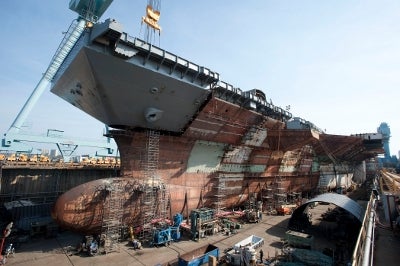
Huntington Ingalls Industries (HII) has successfully completed installation of the upper bow section on the US Navy’s first Gerald R Ford-class nuclear-powered aircraft carrier, CVN 78, at the company’s Newport News Shipbuilding (NNS).
Representing the completion of flight deck on the carrier, which weighs 787mt and comprises 19 steel sections, the Gerald R Ford vessel is now 96% complete in its structural development programme.
The upper bow is one of the 496 units used to construct the carrier in the dry dock and joins the lower bow section, which was installed on 24 May 2012.
NNS CVN 78 carrier construction vice-president Rolf Bartschi said: "We have now structurally erected the flight deck to its full length."
Designed to replace Nimitz-class aircraft carriers for the US Navy, the Ford-class carriers will be armed with the Raytheon evolved Sea Sparrow missile (ESSM) to strike against high-speed, highly manoeuvrable anti-ship missiles, as well as a rolling airframe missile (RAM) close-in weapon system.
The aircraft carrier features a new nuclear power plant, a redesigned island, electromagnetic catapults, improved weapons movement and an enhanced flight deck for increased aircraft sortie rates.
Additional features of the ship include flexibility for the implementation of future technologies and $4bn reduced total ownership cost when compared with a Nimitz-class aircraft carrier.
The 100,000t Ford-class ships will be capable of operating up to 90 aircraft, which includes the F-35 Joint Strike Fighter, F/A-18E/F Super Hornet, E-2D Advanced Hawkeye, EA-18G Growler electronic attack aircraft, MH-60R/S helicopters and unmanned air vehicles and unmanned combat air vehicles.
Scheduled to launch later this year, the 1,092ft-long Gerald R Ford will have a beam of 134ft and can arm, refuel, launch and recover aircraft quickly.
The second ship of the class, John F Kennedy (CVN 79) is also currently under construction and is expected to be complete in 2020.
Image: The first Gerald R Ford carrier being integrated with the flight deck. Photo: courtesy of Huntington Ingalls Industries, Inc.








